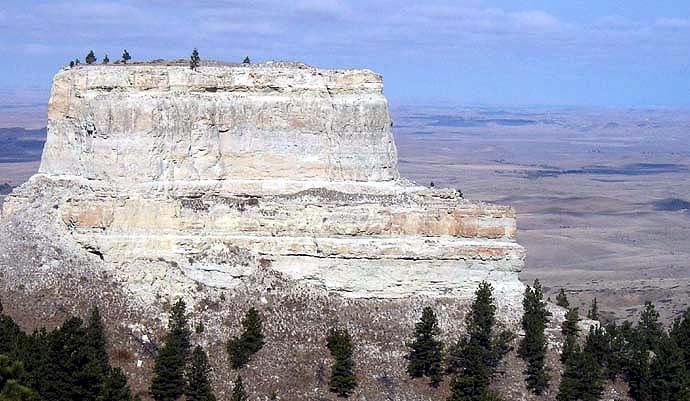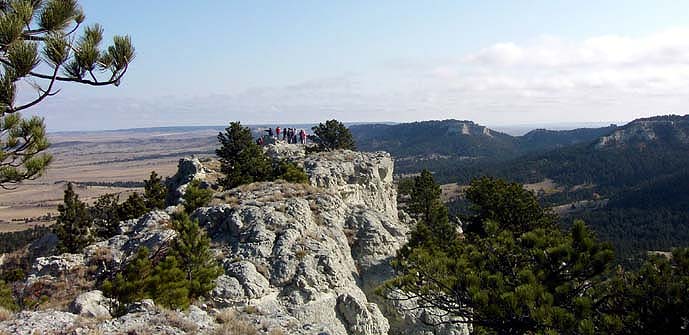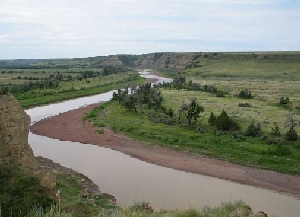Eastern Montana, along with the eastern portions of states to the south, is very much like the western sections of the Dakotas, Nebraska, and Kansas, being relatively high in altitude and undergoing cyclical weather conditions that include drought. It was, in former times, called "The Prairie." a vast dry grassland of rolling hills, cut by dry washes and coulees, with occasional shallow rivers.
For many folks who are familiar with this portion of the USA, but unfamiliar with Southeastern Montana, the notion of a National Forest existing in this country seems absurd. However, the distances in this area are great, and one can often travel for 50 or even 100 miles without seeing much in the way of trees. But remote sections of the Custer National Forest are located here, and my destination was my friend's cabin, just over the border in Camp Crook, South Dakota.
The general impression of this country is that it is desolate and barren. Nothing could be further from the truth. Native American nomadic tribes coveted and warred over this area, which, beside the buffalo herds of 150 years ago, teemed with deer, antelope, wild turkey and other wildlife. While the buffalo are gone, the other wildlife remains in relative abundance.


(note: these pictures were taken from the Chalk Buttes, an area a few miles to the northwest of the Long Pines, and very similar in appearance. I included them because they give a perfect impression of the landscape.)
The main river in this area of the country is the Little Missouri River.

(note: this picture is, I believe, from North Dakota, but is the best I could do in recreating the idea of what the river's course in Montana, further upstream, is like.)
This entire area would have provided a very bountiful existence to the limited populations of nomadic Native Americans before the white man began to settle the area. In fact, this entire part of the country, along with the Black Hills to the southeast, was reserved to the Sioux tribes by treaty. The discovery of gold in the Black Hills gave whites the impetus to enter Sioux lands, treaty or not.
Near Camp Crook in South Dakota, near Ludlow, my friend had told me of an archeological discovery: It seems as a raiding party had stopped to divide the spoils of a raid on another tribe and had stopped by some rocks to bash the brains out of infants taken in the raid. Archeologists had uncovered the site and were working on it during my friend's tenure on the Custer National Forest there.
Of course, further to the west is the famous Custer National Battlefield, which is also similar in appearance to the area around Ekalaka, Montana and Camp Crook, South Dakota. I've visited this site many times, both out of my own interest in the event and because my Wife has relatives buried in the military cemetery next to the Battlefield.
Not only was this area a unfrequented hunting spot, it was also a very historical and scenic region of the American West.
My early efforts at hunting began south of Camp Crook, where the Little Missouri is inside of the Montana state line. My friend and I went with one of the locals, who worked with my friend, and we explored an area right along the riverbank. I was using my Ruger #1 in 270, with a 4x Leupold scope and Remington 130 gr. bronze points. After maybe an hour or so of working through the tall cottonwood trees and thick vegetation about 300 yards away from the bank, we came upon a small group of deer with a nicely sized buck, which I took a shot at and missed. The deer ambled, rather than bolted, toward the river and crossed. (I suppose they really weren't hunted so much as to be spooky.)
We followed and Mike, the local, took right off across the frozen surface of the Little Missouri. He was quite a bit smaller than me, and I found the cracking sounds in the ice quite disconcerting! I didn't think I could swim too well in my woolens and with a pack. However, after crossing the river and scouting about, it was clear these deer were gone for good.
Later on, my friend told me that Mike had asked whether I could actually shoot. John had told him that I could, but I don't think Mike was very convinced after my morning's performance.
In the afternoon, we went up into the hills, which were covered with abundant woods and criss-crossed by various deep ravines. The views across the surrounding plains were quite spectacular. In one section, we saw a dead cow at the bottom of a large, wide ravine, and a pair of eagles were circling it. One was a bald eagle and the other was a golden (these birds are both large, but very distinguishable in color) and I have since understood that it is quite rare to see them together like this.
Further on in the day, we came across some turkeys. My friend had advised me to get a turkey tag, since the birds were plentiful in the area and he thought I might get a shot. As it was, a nice tom and some hens were poking along when we came up on them. I had my 45 ACP with me and had laid a nice sight on the tom's neck when he took off and roosted on a tree some distance away -- unfortunately it was the only opportunity I had to fill my turkey tag.
The next day, my friend and I hunted alone. We spent most of the day poking in promising areas, but to no avail. Finally, late in the afternoon, we were northeast of Camp Crook and looking for a likely place to finish off the day, when we came upon a number of deer in an opening as we rounded a corner. John pulled off of the road quickly and shut off the engine, and we sat for a bit, as the deer didn't seem too spooked by my truck. I inched out of the passenger's side after John and, taking a nice rest on the hood, held on the heart of a nice buck and touched off.
Immediately, the buck dropped to the ground as if he'd been clubbed on the head. In a short time, I found that this is exactly what had happened. Running up, I quickly reloaded and at about 30 or so yards, it was clear that the buck was getting up. Just as he got to his feet, I quickly put another round right in the boiler room and he was finished for good.
John and I looked the buck over, and he was of nice size with a modest 3 point rack. (We count one side only out West…) As we looked him over for where my first shot had hit him, we discovered that it had creased him right on top of the head, between the antlers. The bullet had gone through clear to the skull, but there was no blood or other injury. In effect, I had knocked him out and only really shot him when we approached more closely.
On the way back to get the truck, I paced off over 270 paces, so I suppose my shooting range was at least 250 yards. It is my practice to sight in 3 inches high at 100 yards, so even at this distance, holding directly on should have put a bullet into the heart-lung area, not hit him on the top of the head!
After gutting him, we took him back and I gave Mike the hide for skinning him for me. After hanging out with John for another day, I headed off for home. We took him to a local game butcher and got about 135 pounds of meat from him as a result -- he was a nice fat buck and quite tasty.
Later on, I took the Ruger out to the range to see just where it was shooting. It turned out that I was not even printing on the paper, even though I had sighted in just before leaving on the trip. Subsequently, I noticed that on every trip to the range, the zero was always different, even though the groups were under an inch.
I found a book in the local library by Frank De Haas on single shot rifles, and he identified the problem: The way Ruger beds the fore end to the barrel ensures a wandering zero whenever the weather changes. De Haas recommended several fixes, including the mounting of a steel block to the bottom of the barrel and bedding the fore end to that. I wasn't too much in the mood to tear into the Ruger in that fashion, so I opted for his "low-tech" cure of installing a metal shim between the under-rib and the fore end, so that the barrel was clearly free floated.
Since doing this simple modification, the #1 has always retained zero and, just before we left Montana, I had set it up with a 12x AO Weaver, and started using it for hunting rockchucks in the mountains.
So, there's a little hunting story to provide company to your cup of tea!










